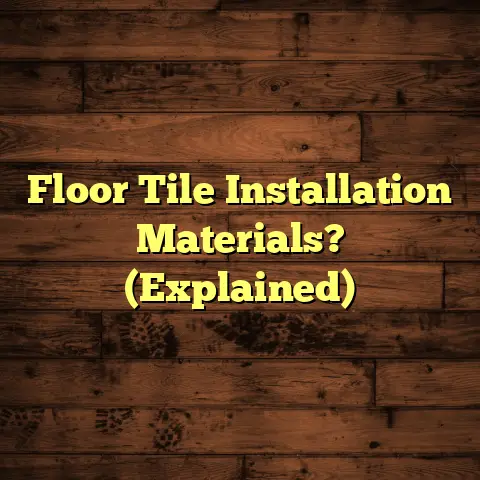Why Floor Squeaks When Walking? (1 Cause = Repair!)
Imagine this: You’ve just settled down for a cozy evening at home, maybe with a good book or a movie queued up.
You take a step towards the kitchen to grab a snack, and suddenly, the peace of your evening is shattered by a loud, unmistakable squeak from the floor beneath your feet.
It’s not just annoying; it’s downright frustrating.
Every step you take feels like you’re walking through a minefield of sound, each creak a reminder of the imperfections in your home.
As a flooring contractor for over 15 years, I’ve seen firsthand how much a squeaky floor can drive homeowners crazy.
It’s like living in a haunted house, only the ghost is your own darn floor!
For many homeowners, the incessant squeaking of floors can become a source of irritation that disrupts their daily lives and undermines the comfort of their living spaces.
But what causes these pesky sounds? And more importantly, how can they be fixed?
In this article, we will delve deep into the reasons behind floor squeaks, focusing on the primary cause and offering a straightforward solution for a repair that can restore peace to your home.
Let’s get started!
Section 1: Understanding the Anatomy of Your Floor
Before we dive into the squeaks, let’s take a quick tour of what’s under your feet.
Think of your floor like a layered cake.
You’ve got the pretty icing on top (the flooring you see), and then the supporting layers underneath.
Brief overview of different types of flooring:
First, let’s talk about the “icing.” This is the flooring you actually walk on.
It could be:- Hardwood: Classic, beautiful, and can last for generations.
- Laminate: A more affordable alternative that mimics the look of wood or tile.
- Tile: Durable and water-resistant, perfect for bathrooms and kitchens.
- Carpet: Soft and cozy, but can be a magnet for dust and allergens.
- Explanation of how floors are constructed and the materials used:
Each type of flooring has its own construction.
Hardwood, for example, is usually solid wood planks or engineered wood (a layer of hardwood on top of plywood).
Laminate is made of layers of synthetic materials pressed together.
Tile is made of ceramic, porcelain, or stone.
Carpet is made of fibers attached to a backing.
Introduction to the concept of subflooring and its role in floor stability:
Now, let’s get to the real foundation: the subfloor.
This is the layer underneath your flooring.
It’s usually made of plywood or OSB (oriented strand board).The subfloor’s job is to provide a solid, stable surface for your flooring to sit on.
Think of it as the cake board that holds everything together.
Without a good subfloor, your flooring is going to have problems.
I’ve seen so many floors ruined because of a bad subfloor.
It’s not something to skimp on!
Section 2: The Science Behind Squeaky Floors
Alright, let’s get down to the nitty-gritty of why floors squeak.
It’s all about movement and friction.
Detailed exploration of the mechanics of floor squeaks:
-
How floorboards interact with the subfloor:
Your floorboards are attached to the subfloor with nails, screws, or adhesive.
When you walk across the floor, you put pressure on the boards.If the boards are securely attached, they won’t move much.
But if they’re loose, they’ll rub against the subfloor or against each other.That rubbing creates the squeaking sound we all know and hate.
* The role of nails, screws, and adhesives in securing floorboards:These fasteners are what keep your floorboards in place.
Over time, they can loosen, corrode, or even break.Nails can pop up, screws can strip, and adhesive can dry out.
When that happens, the floorboards lose their grip on the subfloor.
* Environmental factors that can contribute to squeaking (humidity, temperature changes):Wood is a natural material, and it expands and contracts with changes in humidity and temperature.
In the summer, when it’s humid, wood absorbs moisture and expands.
In the winter, when it’s dry, wood loses moisture and contracts.I’ve seen floors that are perfectly quiet in the summer turn into squeak symphonies in the winter.
It’s all about the wood reacting to the environment.
-
Section 3: Identifying the Main Cause of Floor Squeaks
Okay, so we know how floors squeak. Now, let’s pinpoint the main reason why.
In my experience, the number one culprit is:
Discussion of the primary cause: loose floorboards.
-
Explanation of how loose floorboards lead to movement and friction:
When floorboards aren’t properly secured to the subfloor, they’re free to move around.
Every time you step on them, they flex and rub against the subfloor or neighboring boards.
This movement is what creates the squeak.
It’s like rubbing two pieces of wood together.
* Signs that indicate loose floorboards (gaps between boards, visible movement, etc.):How can you tell if you have loose floorboards?
Here are some telltale signs:- Gaps between boards: If you see noticeable gaps between your floorboards, that’s a sign they’re not tightly connected.
- Visible movement: If you can see or feel the floorboards move when you step on them, they’re definitely loose.
- Squeaking: Obviously, if your floor is squeaking, that’s a good indication that something’s not right.
- Popped nails or screws: Look for nails or screws that are sticking up above the surface of the floor.
-
I once worked on a house where the floorboards were so loose, you could practically lift them up with your hands!
It was a squeak orchestra in there.
Section 4: The Impact of Floor Squeaks on Homeowners
Squeaky floors might seem like a minor annoyance, but they can actually have a pretty big impact on your life.
Emotional and psychological effects of living with squeaky floors:
Let’s be honest, living with constant squeaking can be stressful.
It can make you feel like you’re constantly being watched or judged.It can disrupt your sleep, make it hard to concentrate, and just generally make you feel on edge.
I’ve had clients tell me that their squeaky floors were driving them crazy and affecting their relationships.
* How squeaky floors can affect home value and marketability:If you’re thinking of selling your home, squeaky floors can be a major turn-off for potential buyers.
They can make your house seem old, poorly maintained, and generally less desirable.
A home inspection will almost certainly flag squeaky floors as an issue, which could lead to price negotiations or even a deal breaker.
According to a 2023 survey by the National Association of Realtors, 47% of home buyers said that the condition of the floors was “very important” in their decision to purchase a home.
* Anecdotal stories from homeowners who have dealt with this issue:I remember one client, Sarah, who was so embarrassed by her squeaky floors that she avoided having guests over.
She told me, “I felt like my house was constantly judging me.
Every time someone walked across the floor, I just cringed.”After we fixed her floors, she said it was like a weight had been lifted off her shoulders.
She finally felt proud of her home again.Another client, Mark, was trying to sell his house, but every potential buyer commented on the squeaky floors.
He ended up having to lower his asking price to compensate for the repairs.
He learned the hard way that squeaky floors can cost you money.
Section 5: The Repair Process – Fixing Loose Floorboards
Alright, enough about the problems. Let’s get to the solutions!
Here’s a step-by-step guide on how to fix those pesky loose floorboards.
Step-by-step guide on how to identify and repair loose floorboards.
-
Tools and materials needed for the repair:
Before you start, gather your supplies.
You’ll need:- Drill: For driving screws.
- Screws: Choose screws that are long enough to go through the floorboard and into the subfloor.
I recommend wood screws for hardwood and subfloor screws for OSB or plywood. - Nail set: For countersinking nails.
- Hammer: For hammering nails (if needed).
- Wood glue: For extra bonding power.
- Wood filler: To fill any holes.
- Sandpaper: To smooth out the wood filler.
- Safety glasses: To protect your eyes.
- Earplugs: To protect your ears from the noise.
- Preparing the area for repair (clearing furniture, cleaning):
Clear the area of any furniture or rugs.
You want to have plenty of space to work.Sweep or vacuum the floor to remove any dirt or debris.
* Detailed instructions on securing loose floorboards (nailing, gluing, using screws):- Locate the squeak: Walk around the area and try to pinpoint exactly where the squeak is coming from.
- Identify the loose floorboard: Once you’ve found the squeak, examine the surrounding floorboards to see which one is loose.
- Drive screws into the floorboard: Using your drill, drive screws through the floorboard and into the subfloor.
Space the screws about 6-8 inches apart.
Make sure the screws are countersunk so they don’t stick up above the surface of the floor. - Add wood glue (optional): For extra bonding power, you can apply a small amount of wood glue to the underside of the floorboard before screwing it down.
- Countersink any existing nails: If there are any nails that are sticking up, use a nail set and hammer to countersink them.
- Fill any holes: Use wood filler to fill any screw holes or nail holes.
Let the wood filler dry completely, then sand it smooth. - Clean up: Vacuum the area to remove any dust or debris.
-
-
Tips for ensuring a long-lasting repair:
- Use the right screws: Make sure you’re using screws that are designed for wood or subflooring.
- Don’t overtighten the screws: Overtightening can strip the screws and make the problem worse.
- Use wood glue: Wood glue can help to create a stronger, more durable bond between the floorboard and the subfloor.
- Consider shims: If the gap between the floorboard and the subfloor is too large, you may need to use shims to fill the space.
I always tell my clients, “Do it right the first time, and you won’t have to do it again.”
Section 6: Preventative Measures to Avoid Future Squeaks
Okay, you’ve fixed your squeaky floors.
Now, how do you keep them from coming back?
Here are some preventative measures you can take:
Discussion on maintenance practices to keep floors secure:
- Control humidity: Keep the humidity level in your home consistent.
Use a humidifier in the winter and a dehumidifier in the summer.
According to the EPA, you should keep your home’s humidity between 30-50%. - Clean regularly: Sweep or vacuum your floors regularly to remove dirt and debris.
- Use floor protectors: Put floor protectors on the legs of your furniture to prevent scratches and dents.
- Avoid excessive weight: Don’t put too much weight on your floors in one area.
-
Importance of periodic inspections and addressing minor issues before they escalate:
-
Inspect your floors regularly: Look for any signs of loose floorboards, gaps, or popped nails.
- Address minor issues promptly: If you notice a small squeak, don’t ignore it.
Fix it before it gets worse.
- Control humidity: Keep the humidity level in your home consistent.
I always recommend that my clients inspect their floors at least twice a year.
It’s like a check-up for your home!
Section 7: Conclusion
Recap of the main points discussed in the article:
So, we’ve covered a lot of ground in this article.
We’ve talked about:- The anatomy of your floor.
- The science behind squeaky floors.
- The main cause of floor squeaks: loose floorboards.
- The impact of floor squeaks on homeowners.
- How to repair loose floorboards.
- Preventative measures to avoid future squeaks.
- Emphasis on the importance of addressing squeaks promptly to maintain home comfort and value:
Squeaky floors might seem like a minor problem, but they can have a big impact on your comfort and the value of your home.
Addressing squeaks promptly can prevent them from getting worse and save you money in the long run.
* Final thoughts on the satisfaction of walking on a quiet, well-maintained floor:There’s nothing quite like the feeling of walking on a quiet, well-maintained floor.
It’s a sign that you take pride in your home and that you care about the details.
So, take the time to fix those squeaky floors.
You’ll be glad you did!
I hope this article has been helpful.
If you have any questions, feel free to reach out to a local flooring contractor.
Good luck!





